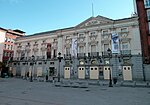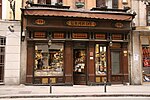Monument to Federico García Lorca (Madrid)
Bronze sculptures in SpainBuildings and structures in Cortes neighborhood, MadridMonuments and memorials in MadridOutdoor sculptures in MadridSculptures of men in Spain ... and 2 more
Statues of writersVandalized works of art in Spain

Federico García Lorca or the Monument to Federico García Lorca is an instance of public art in Madrid, Spain. Located at the Plaza de Santa Ana, in front of the Teatro Español, it consists of a bronze statue of the aforementioned poet and playwright.
Excerpt from the Wikipedia article Monument to Federico García Lorca (Madrid) (License: CC BY-SA 3.0, Authors, Images).Monument to Federico García Lorca (Madrid)
Plaza de Santa Ana, Madrid
Geographical coordinates (GPS) Address External links Nearby Places Show on map
Geographical coordinates (GPS)
| Latitude | Longitude |
|---|---|
| N 40.414755555556 ° | E -3.7005111111111 ° |
Address
Estatua Federico García Lorca
Plaza de Santa Ana
28012 Madrid (Centro)
Community of Madrid, Spain
Open on Google Maps










